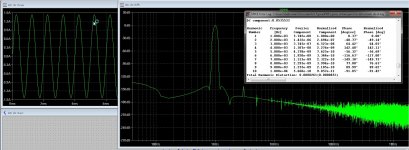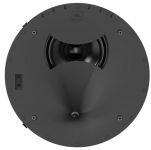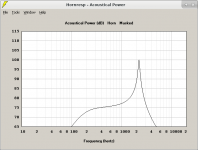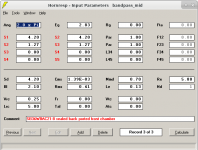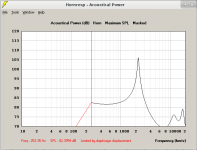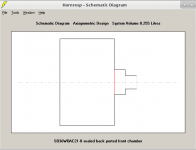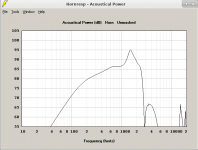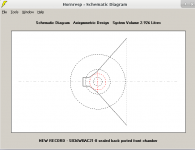Closing the back raises the resonance and causes a peak in the response there but limits excursion. All together you get more SPL but loose BW on the low end. The mids become power limited rather than excursion limited.
Moving in the other direction - open back, more box volume, you can extend the low end response but you need to watch the excursion, especially if you extend low end response below your horn's pattern control limit frequency. Choose your poison. Don't be ruled by that formula, trust your HR simulation. It will tell you closed back volume as well, if you choose to go that way.
Moving in the other direction - open back, more box volume, you can extend the low end response but you need to watch the excursion, especially if you extend low end response below your horn's pattern control limit frequency. Choose your poison. Don't be ruled by that formula, trust your HR simulation. It will tell you closed back volume as well, if you choose to go that way.
I somehow cannot understand the idea of using a closed back driver. Let's say I have a closed back midrange with resonant frequency of 450 Hz. Does that mean I am limited by this frequency on the low end crossover point or was the formula something like 0.707 * fs for the low crossover point?
If I wanted to make my own closed back midrange (out of FaitalPro 3FE22 8 ohm version) with 3D printing a custom back enclosure, for what Q and fs should i target the volume of the back enclosure ideally? My target for the low crossover point would be ca 300 Hz, the high crossover point as high as possible. Is that doable with this speaker?
Edit: Using the formulas at the beginning of the thread get me the following numbers 2fs/Qes = 423 Hz. I should calculate the volume to get a Qt of 0.707, which is around 1l. Am I correct?
NC535 answered the question nicely.
Some things I would add:
- The Unity and Synergy horns are designed to produce maximum output. Going with a closed back midrange can significantly increase output, by as much as six or even ten decibels. We are basically trading bandwidth for output.
- When you put a speaker on a horn, you raise the output. A sealed baack enclosure can by synergistic with this. Basically a closed back midrange on a baffle will have a peak on the low end, a peak of as much as 6-10dB. (See above.) With some tinkering, you can use that peak in output to seamlessly transition to the range where horn loading ALSO raises your output. If you do this carefully, you can get the speaker to play lower than it normally would with an undersized horn. Google "reactance annulling."
- These days I mostly avoid closed back midranges. This is because there aren't many for sale. Due to this, my Unity horns have to use taps that are larger than I'd like. Basically, if you're running a wider bandwidth, you have to make the taps bigger to compensate. Check out the SPL Runt, and note how the taps are about 400% bigger than the taps on a SPL-TD1.
- I have tried to 3D print midrange enclosures, but the results were never great. Basically there's a tremendous amount of pressure in the enclosure and leaks are a real issue. If I were going to use a closed back midrange, I would probably just BUY a closed back midrange. If you DO 3D print an enclosure, be sure to put some time and effort into sealing it off using mortite or a proper gasket, and probably dip the whole thing in epoxy or something comparable. The pressure generated by the midrange will easily push the air right through the microscopic gaps between the layers of your 3D print.
my solution to sealing the back of my mids was paper mache which I then coated with a layer of 'liquid nails'. It was very easy to see if the mids where properly sealed from the impedance plot of each driver. However this took a long time due to needing to layer the paper and is messy.
2 way Synergy inspired by SPL Runt
I used 3D printed backs on a Runt clone with 8PE21 and it does exactly what I needed. Pretty solid and not too leaky I would say. I print in PLA, 5 perimeters, slight over extrusion and without cooling. That makes the box leakproof. I usually seal the print with some acrylic spray paint, that should fill any pores that may be left.
So I can print a back enclosure of the needed volume dictated by Hornresp.
I used 3D printed backs on a Runt clone with 8PE21 and it does exactly what I needed. Pretty solid and not too leaky I would say. I print in PLA, 5 perimeters, slight over extrusion and without cooling. That makes the box leakproof. I usually seal the print with some acrylic spray paint, that should fill any pores that may be left.
So I can print a back enclosure of the needed volume dictated by Hornresp.
Here's another vote for the 4NDF34,
and what i came up with to enclose them.
Not exactly a 'sealed-back' solution, but the enclosure volume is right at 1L per driver. (Two drivers per each side enclosure.)
Using four of them with port centers 3.5" from throat, I get the raw response below.
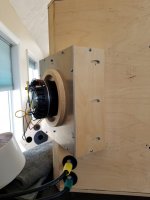
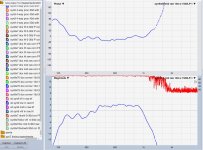
The other 4" i played with was the 4FE35. Very nice too, a bit better low end response....just a lot less efficiency.
and what i came up with to enclose them.
Not exactly a 'sealed-back' solution, but the enclosure volume is right at 1L per driver. (Two drivers per each side enclosure.)
Using four of them with port centers 3.5" from throat, I get the raw response below.


The other 4" i played with was the 4FE35. Very nice too, a bit better low end response....just a lot less efficiency.
Mark, this is a very neat solution. I am better at 3D printing than wood working, so I will just print some back covers, the 3FE22s need slightly larger volume than fully closed basket for optimal response. The 4NDF34s are on my wish list, which may turn into shopping list one day🙂
I'm looking to go higher than the usual ~1kHz, thoughts on SB36WBAC21-8. I would use 4 for a low SPL bookshelf style speaker in 3 way. It would cover (Idealy) 400 - 2000 Hz.
Seems possible. Make a simulation. I've been after a driver for similar application. Look at this little driver too:
https://en.toutlehautparleur.com/un...e-speaker-vifa-tc5fc07-04-4-ohm-1-5-inch.html
http://www.5een.co.uk/TC5FC07-04.htm
http://feleppa.com.au/speakermeasmid.html
https://en.toutlehautparleur.com/un...e-speaker-vifa-tc5fc07-04-4-ohm-1-5-inch.html
http://www.5een.co.uk/TC5FC07-04.htm
http://feleppa.com.au/speakermeasmid.html
based on the math from page one in this thread, getting that driver to do 1khz will be difficultI'm looking to go higher than the usual ~1kHz, thoughts on SB36WBAC21-8. I would use 4 for a low SPL bookshelf style speaker in 3 way. It would cover (Idealy) 400 - 2000 Hz.
I've been able to get drivers to play higher than you would expect, but the key seems to be to use a driver where you can leverage the high frequency resonance, particularly from the dust cap
This requires trial and error unfortunately, there's no easy way to predict if some drivers will "ring" to play higher
I like the Dayton ND64-16 because it was explicitly designed to ring (Keele says so, he designed it)
It was used in his CBT, and he had some mods done so that it would decouple at high frequency, to exaggerate the output above 1khz
I am no longer a fan of 2" or 1" drivers in Unity horns, because they're a p.i.t.a. to wire up, and a single 4" driver can replace FOUR two inch drivers
Here's an example of JBL using a fairly simple phase plug design on the midbass, so that output from the dust cap can extend the high frequencies beyond what would be possible if the majority of the cone was masked off.
Attachments
So by positioning my mid driver dust cap over the tap I might be able to extend the mid high frequency response?
Ok but if I model the SB36WBAC21-8 in a tiny bandpasss chamber I easily get over 2 kHz, maximum SPL graph indicates perhaps a crossover as low as 300 Hz would be possible also. For a 2kHz notch caused by the throat reflection the injection port would be 4.3cm from the compresion driver diaphragm (I don't have the parts on hand but I think this might be possible).
Attachments
the negatives are 75 db sensitivity and only 5W power handling but other than that looks good
I modeled 4 of them on an approximation to the Dayton Audio H6512 6-1/2" x 12" Waveguide 1-3/8"- 18 TPI distance from the throat is a bit of a guess. If I increase the front chamber volume significantly or increase the tap to throat distance (2.5cm from end of compresion driver thread) I won't hit a 2kHz crossover so I think for this application I will have to use the 1" drivers. Without directivity effects of the horn max SPL is 95dB using 4 drivers which should be fine for desktop application. As an indication speakers like the Kali Audio IN-8V2 have limiters engaging around this level.
Attachments
Why not mate it with a 3/4 - 1" dome IF it is low SPL anyway? Compression driver seems overkill...
I replaced the tweeters of some JBL EON 612 so have the spare magnets for the drivers (JBL 2414H-1), china diaphragms look like the real thing and are cheapish so I can build a pair of working comps for £27.30 inc postage. I noticed a simlar driver performs well on the H6512 waveguide (2414H-C). I'm very keen on point source speakers and wanted something small for my desktop so I then need a midrange that can meet this comp which from my experience with simlar drivers I expect to be fine down to around 2kHz. This type of comp is just a simple mylar dome and basic phase plug they arn't much more complicated than a dome tweeter. I'm not much of a fan of uncontrolled directivity speakers especialy in difficult enviroments like desktops.
Last edited:
I am so pleased to observe the "turn" this thread has taken lately.
I am talking about the control and increase of bandwidth for the MF driver i a MEH.
You see, I have been a bit confused with some of the projects shown here, using biig buckets as midrange drivers.
IMHO such diaphragm volume would shunt higher frequencies, thus limiting bandwidth, or necessitate large MF ports which would then "trap" waves from the HF driver.
I was able to push a 300 to 2KHz bandwidth from Visaton FRS 5X 2" drivers with 14mm ports in my "Rashorns", being basically copies of Bill Waslos "Cosynes".
https://drive.google.com/drive/folders/1rrCIM33Wo9ByMDgL56Xx4wsSk1ahECLI?usp=sharingHowever, I am intrigued to push it higher in my next project (which may last awhile, though).
So, the suggestions from Kipman and Person in post 2409 and 2410 are indeed interesting !
Allow me also to suggest Visaton BF 37-8, introduced recently and therefore perhaps around for a while.
YES, they are small, but still, 4 pcs. 1.5" drivers equals 1 pc. 3" driver which was what everybody was using for HiFi midranges not-so-long-ago, the former with much more power handling, though.
The very small diaphragm volume should make 3 Khz within reach.
Further, small MF drivers gives a better chance to correct fitting near S1, and smaller ports in order not to shunt or rag the HF driver response.
And, as Bateman states above in post 2403 one WILL trade output for bandwidth.
Since Kipman/Person are way ahead of me, allow me to make some suggestions/advise based on the experience I have obtained:
A MEH MF response is dominated by 3 sections:
1. The low section by the driver/rear chamber. Use HR, but:
Can we perhaps use an "Isobarik" system in a 3D printed rear chamber ? (i.e. two drivers in close coupling). This should yield a lower cut-off for the same rear volume (and 8 MF drivers per horn :-/ ). For such small drivers, the rear chamber may only increase about 25mm in build length, not width.
2. The mid section is dominated by the horn. Use HR.
3. The high section is dominated by the diaphragm/port volumes, giving a controlled resonance. Use HR, but:
Kindly view the studies I made in the link above, line 7.
One study shows that concentric ports give much better control of this resonance, being symetric and well-defined, not as ragged as excentric ports.
HR, it seems, take this point for granted, but everybody (including me) has been making excentric ports....
I am talking about the control and increase of bandwidth for the MF driver i a MEH.
You see, I have been a bit confused with some of the projects shown here, using biig buckets as midrange drivers.
IMHO such diaphragm volume would shunt higher frequencies, thus limiting bandwidth, or necessitate large MF ports which would then "trap" waves from the HF driver.
I was able to push a 300 to 2KHz bandwidth from Visaton FRS 5X 2" drivers with 14mm ports in my "Rashorns", being basically copies of Bill Waslos "Cosynes".
https://drive.google.com/drive/folders/1rrCIM33Wo9ByMDgL56Xx4wsSk1ahECLI?usp=sharingHowever, I am intrigued to push it higher in my next project (which may last awhile, though).
So, the suggestions from Kipman and Person in post 2409 and 2410 are indeed interesting !
Allow me also to suggest Visaton BF 37-8, introduced recently and therefore perhaps around for a while.
YES, they are small, but still, 4 pcs. 1.5" drivers equals 1 pc. 3" driver which was what everybody was using for HiFi midranges not-so-long-ago, the former with much more power handling, though.
The very small diaphragm volume should make 3 Khz within reach.
Further, small MF drivers gives a better chance to correct fitting near S1, and smaller ports in order not to shunt or rag the HF driver response.
And, as Bateman states above in post 2403 one WILL trade output for bandwidth.
Since Kipman/Person are way ahead of me, allow me to make some suggestions/advise based on the experience I have obtained:
A MEH MF response is dominated by 3 sections:
1. The low section by the driver/rear chamber. Use HR, but:
Can we perhaps use an "Isobarik" system in a 3D printed rear chamber ? (i.e. two drivers in close coupling). This should yield a lower cut-off for the same rear volume (and 8 MF drivers per horn :-/ ). For such small drivers, the rear chamber may only increase about 25mm in build length, not width.
2. The mid section is dominated by the horn. Use HR.
3. The high section is dominated by the diaphragm/port volumes, giving a controlled resonance. Use HR, but:
Kindly view the studies I made in the link above, line 7.
One study shows that concentric ports give much better control of this resonance, being symetric and well-defined, not as ragged as excentric ports.
HR, it seems, take this point for granted, but everybody (including me) has been making excentric ports....
- Home
- Loudspeakers
- Multi-Way
- Suitable midrange cone, for bandpass mid in Unity horn
